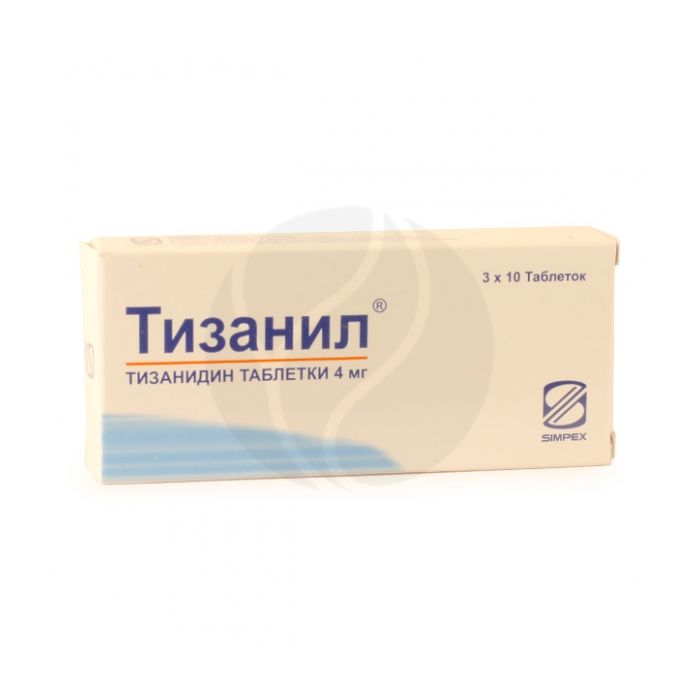Tizanil tablets 4mg, No. 30
Expiration Date: 05/2027
Russian Pharmacy name:
Тизанил таблетки 4мг, №30
painful muscle spasm associated with static and functional diseases of the spine, as well as after surgical interventions;
spasticity of skeletal muscles in neurological diseases (multiple sclerosis, chronic myelopathy, degenerative diseases of the spinal cord, cerebrovascular accident, cerebral palsy (in patients over 18 years of age).
Inside.
For painful muscle spasm: 2-4 mg three times / day. In severe cases, an additional 2-4 mg is taken before bedtime.
With spasticity of skeletal muscles: the initial daily dose should not exceed 6 mg, divided into 3 doses. The dose can be increased gradually by 2-4 mg at intervals of 3-7 days. The optimal therapeutic effect is usually achieved with a daily dose of 12-24 mg, divided into 3-4 doses at regular intervals.
The maximum daily dose is 36 mg. In patients with renal insufficiency, it is recommended to start treatment with a dose of 2 mg 1 time / day. The dose increase should be carried out gradually, focusing on tolerance and efficacy. If it is necessary to increase the dose, first increase the dosage prescribed 1 time per day, after which the frequency of administration is increased
Pills
1 tab.
tizanidine (as hydrochloride) 2 mg; 4mg
severe liver dysfunction;
simultaneous use with fluvoxamine;
age under 18;
pregnancy and lactation;
hypersensitivity to any component of the drug.
With care: renal failure, advanced age, simultaneous use with CYP1A2 inhibitors (antiarrhythmic drugs (amiodarone, mexiletine, propafenone), cimetidine, fluoroquinolones, rofecoxib, oral contraceptives, ticlopedin).
pharmachologic effect
By stimulating presynaptic ? 2 receptors, it inhibits the release of excitatory amino acids that stimulate receptors for N-methyl-D-aspartate (NMDA receptors). As a result, at the level of intermediate neurons of the spinal cord, the polysynaptic transmission of excitation is suppressed. Since it is this mechanism that is responsible for excess muscle tone, then when it is suppressed, muscle tone decreases. It also has a central, moderately pronounced analgesic effect.
Pharmacokinetics
It is absorbed quickly and almost completely. The maximum concentration in blood plasma is reached approximately 1 hour after administration. Due to the pronounced metabolism during the 'first pass' through the liver, the average bioavailability is about 34%. Plasma protein binding 30%. In the dose range from 4 to 20 mg, the pharmacokinetics of tizanidine are linear. Interindividual variability of pharmacokinetic parameters is low. Gender does not affect the pharmacokinetics of tizanidine. It is metabolized in the liver, mainly by the isozyme 1A2 of the cytochrome P450 system. The metabolites are inactive. The half-life is 2-4 hours. It is excreted mainly by the kidneys in the form of metabolites, a small part - unchanged.In patients with renal insufficiency (creatinine clearance less than 25 ml / min), the mean maximum plasma concentration was 2 times higher than that in healthy volunteers, and the half-life was extended to 14 hours. Simultaneous food intake does not have a clinically significant effect on the pharmacokinetics of tizanidine.
Side effect
Drowsiness, weakness, dizziness, a slight decrease in blood pressure, dry mouth, nausea, gastrointestinal disorders, a transient increase in the activity of hepatic transaminases. When taking the drug in higher doses additionally, there may be: a decrease in blood pressure, bradycardia, muscle weakness, insomnia, sleep disorders. hallucinations, acute hepatitis (very rare), anxiety.
Application during pregnancy and lactation
Contraindicated during pregnancy and lactation.
Application for violations of liver function
Contraindicated in severe liver dysfunction. Liver dysfunction associated with tizanidine has been reported. However, with a daily dose of up to 12 mg, these cases were rare. It is recommended to monitor liver function tests once a month in the first 4 months of treatment, and if serum ALT and ACT levels persistently exceed the upper limit of the norm by 3 times or more, the use of tizanidine should be discontinued.
Application for impaired renal function
With caution: renal failure.
Application in children
Contraindicated in children under 18 years of age.
Use in elderly patients
With care: old age.
special instructions
Liver dysfunction associated with tizanidine has been reported. However, with a daily dose of up to 12 mg, these cases were rare. It is recommended to monitor liver function tests once a month in the first 4 months of treatment, and if serum ALT and ACT levels persistently exceed the upper limit of the norm by 3 times or more, the use of tizanidine should be discontinued. Patients who are drowsy should refrain from types of work that require a high concentration of attention and speed of psychomotor reactions (for example, driving vehicles or working with machines and mechanisms).
Overdose
Symptoms: nausea, vomiting, decreased blood pressure, dizziness, drowsiness, miosis, anxiety, respiratory failure, coma. Treatment: multiple use of activated carbon is recommended to remove the drug from the body. Forced diuresis may also accelerate the elimination of tizanidine. In the future, symptomatic therapy is carried out.
Drug interactions
Concomitant use with fluvoxamine results in a 33-fold increase in the area under the concentration-time curve of tizanidine. As a result, a prolonged decrease in blood pressure develops, drowsiness, weakness and lethargy. With the simultaneous use of tizanidine with antihypertensive drugs (including diuretics), the development of arterial hypotension and bradycardia is possible. Sedatives and ethanol can increase the sedative effect of tizanidine. Concomitant use of oral contraceptives leads to a significant decrease in the clearance of tizanidine.

